Herculaneum is located on the Bay of Naples in southern Italy.
It is an archaeological site destroyed by the same Mt. Vesuvius colossal eruption that ruined Pompeii.
Although both sites were completely ruined, Herculaneum was covered under the volcanic ash and pumice, preserving it intact.
Unline Pmpeii, Herculaneum was relatively modest in size, covering around 20 hectares (one-quarter of Pompeii) for roughly 4000 residents.
Hence, Herculaneum’s smaller area and straightforward layout make it easier to explore Pompeii.
The Herculaneum Ruins map will help you understand and navigate the site effortlessly.
Map of Herculaneum
With a map in hand, the next thing you need is the perfect ticket to Herculaneum which includes an audio guide that goes with your navigation:
The site is divided into three parallel streets, going north to south (Cardo III, IV, and V) and two that run up and down (superiore and inferiore).
Two main streets (Decumano Inferiore and the Decumano Massimo) going east to west intersect these streets.
After exiting the ticket building, pass through a turnstile and follow the pathway beneath the site towards the entrance.
The long pathway entrance gives you fine views of the Roman town with a Mount Vesuvius background.
The ramp turns around the southern end, offering access to a metal ramp leading to a tunnel carved out of solid rock, emerging at the ancient shoreline.
From here, you will have a direct view of the seafront houses, especially the House of the Deer.
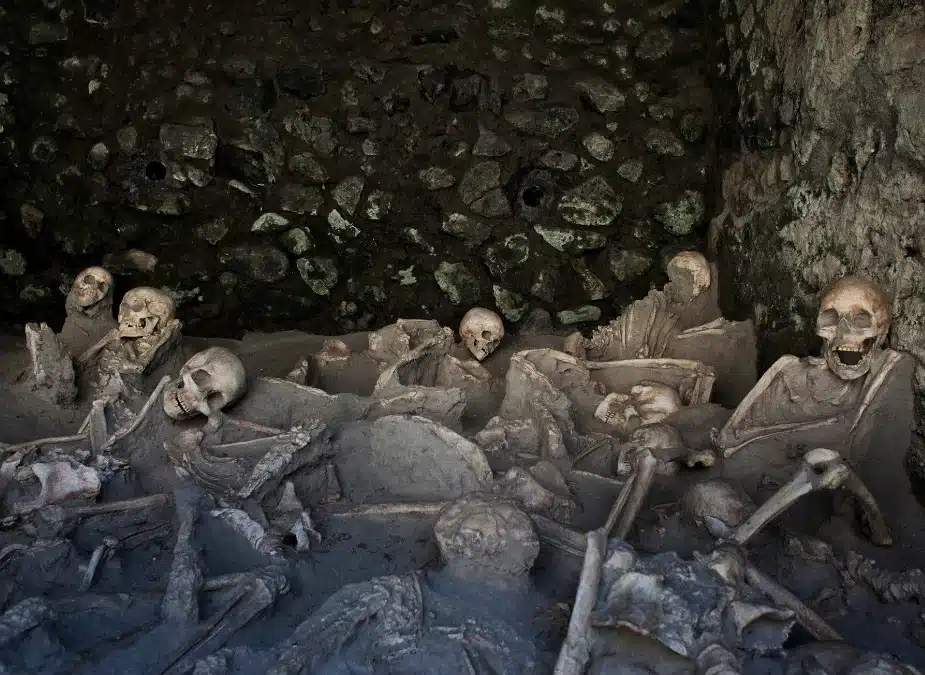
The skeletons found in Herculaneum
Right beneath the houses are twelve vaulted rooms that once opened onto the beach.
Initially, it was possibly boat storage, but tragically, it became the resting place of hundreds of Herculaneum inhabitants.
Around 300 skeletons, along with some of their valuables, were buried here when they were trying to escape from the eruption but were unfortunately killed instantly by the intense heat of the volcanic eruption.
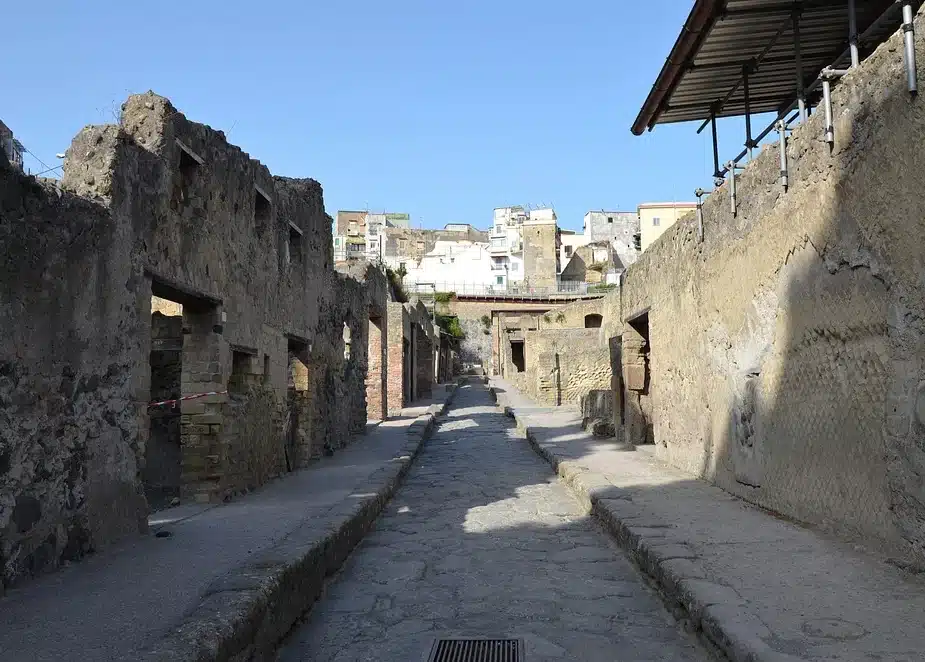
Cardo III Superiore
Further towards the right, a recently constructed footbridge provides direct access to Cardo III, one of the north-south main streets.
On the left side, you’ll find the House of Argus, showcasing a garden with columns that opens into a dining room and other living spaces.
This prestigious residence was initially accessed from Cardo II, which remains undiscovered.
Across Cardo III, on the left side, stands the House of the Skeleton it got its name from discovering a human skeleton in one of its rooms in 1831 CE.
It includes a nymphaeum comprising two rectangular basins with an intricately designed rear wall crafted from inlaid limestone.
The decorative area above the nymphaeum is a decorative frieze consisting of seven panels, though only three original panels remain intact.

College of the Augustales in Herculaneum
At the north-western corner of Cardo III Superiors, you will find the College of the Augustales.
The interiors of the building are rich in mythological wall paintings and are often associated with the imperial cult in Herculaneum.
However, it could have been the town council, the local Curia or the Senate House meeting place.
Inside, you’ll notice a big room with a small shrine (sacellum) adorned with ‘fourth style’ frescoes.
On the left wall, Hercules is standing with Juno and Minerva. The other wall depicts the God of all water and the world’s rivers, Hercules and Achelous, kidnapping Deianira.
A marble inscription on the wall shows two brothers, Aulus Lucius Proculus and Aulus Lucius Iulianus, who hosted a dinner for the Decuriones and Augustales.
This event was to celebrate the dedication of a statue or altar to Augustus.

Painting of Wine Jugs
The town’s primary east-west street, Decumanus Maximus (Decumani Massimo) is on the right of the College of the Augustales.
The street was lined with various shops, including one named Ad Cucumas.
There’s a wall painting displaying four different colored wine jugs sold there, each labeled with a different cost per weight.
The next street will take you to Cardo IV, containing many of the most popular houses.
You’ll first encounter the most luxurious mansions of Herculaneum, the House of Black Hall.
The house’s grand entrance still showcases the carbonized remains of its frame and architrave.
The house layout follows the traditional vestibule, atrium, tablinum, and peristyle sequence.
Some rooms feature sophisticated ‘fourth style’ paintings, with black central panels adorned with architectural motifs.
Across Cardo IV Superiore, you’ll find the House of the Beautiful Courtyard, with its inner courtyard and staircase leading to an upper floor.
Adjacent to it is the House of Neptune and Amphitrite, named for the beautiful decoration in its summer triclinium (open-air dining area).
The east wall of this room features a mosaic of the god Neptune and his sea-nymph wife, Amphitrite.
The triclinium also houses a nymphaeum adorned with a glass paste mosaic and shells.
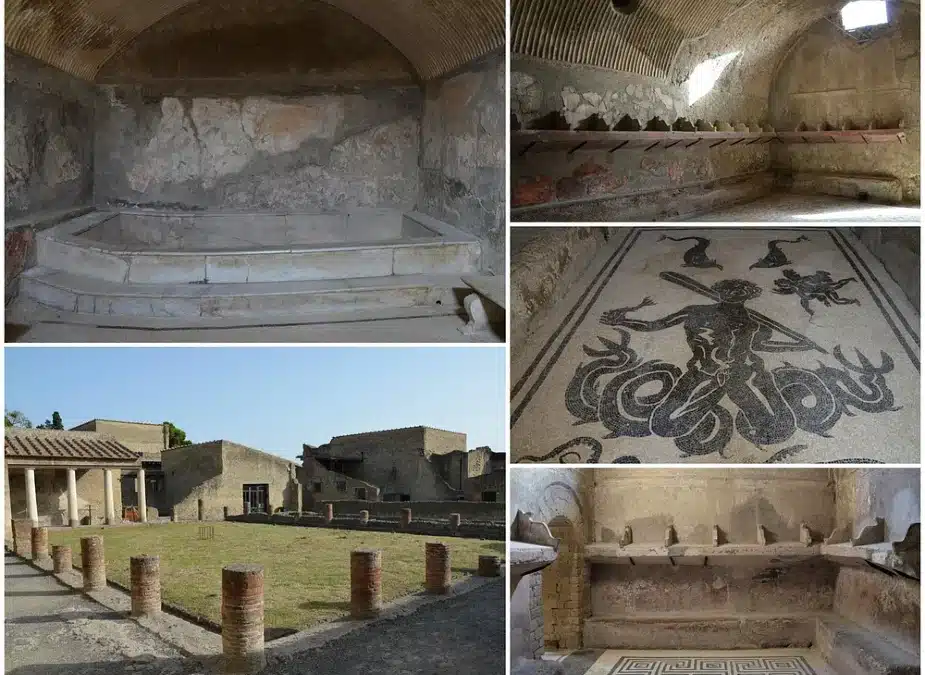
The Central Baths of Herculaneum
On the opposite side, the Central Baths occupy the entire block between Cardo III and Cardo IV.
Constructed at the beginning of the 1st century CE and segregated into men’s (larger) and women’s (smaller) facilities.
Each facility features a sequence of changing rooms (apodyterium), hot rooms (caldarium) and warm rooms ( tepidarium).
Decorated with ‘fourth style’ frescoes, these baths had fine stuccoed ceilings and elegant marine mosaics.
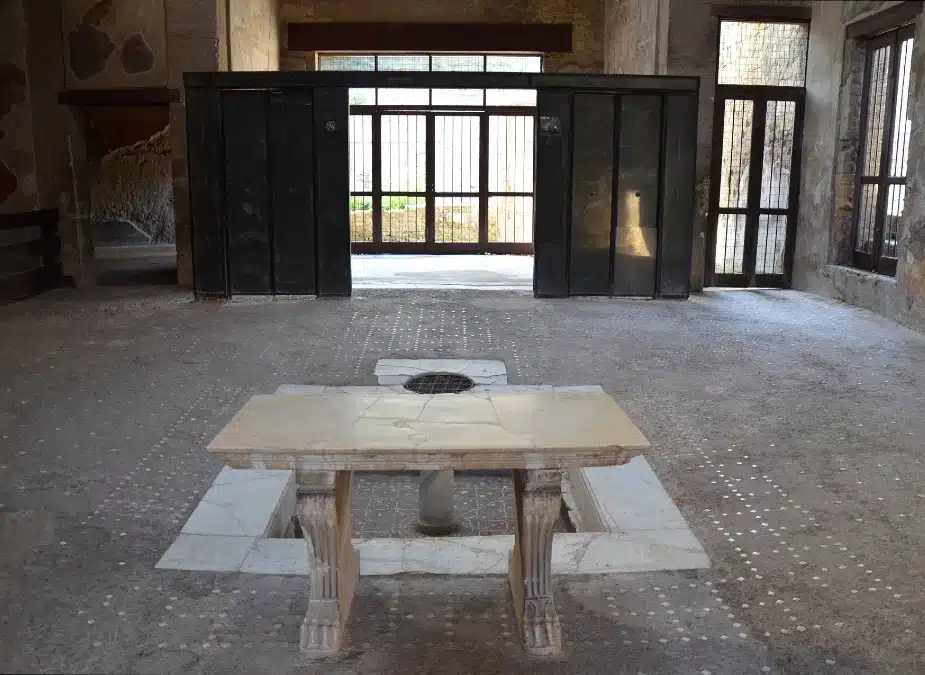
The Atrium of the House of Wooden Screen
Continuing downhill on Cardo IV Inferiore is the House of the Wooden Screen, known for its remarkable perseverance of wooden partition, dividing the atrium from the tablinum (reception area).
The adjoining Trellis House has undergone restoration to highlight its timber-framed facade and balcony.
It features horizontal and vertical wooden panels filled with rubble and concrete.
This technique was known as opus craticium, which was cost-effective, considered not very solid, and more susceptible to fire.
Despite this, the house contains well-preserved carbonized furniture, including cupboards and beds.

The Palaestra in Herculaneum, Thermopolis in Herculaneum
Towards the end of Cardo IV is the Mosaic Atrium House, displaying a black and white geometric mosaic covering the entire atrium floor.
The site’s eastern edge is dominated by the partially excavated Palaestra, a generous gymnasium accessed via a substantial vestibule from Cardo V.
Constructed between 27 BCE and 14 CE, it features a portico with fluted Corinthian columns on three sides and a cryptoporticus on the north side to uphold the terrace above.
Multiple stores built adjacent to the monument caterers to the visitors of Palaestra, providing various amenities, including a bakery (pistrinum).
Descending toward Cardo V Inferiore, near its intersection with Decumano Inferiore, lie the remains of a Thermopolis—a historical cook-shop that served food and beverages.
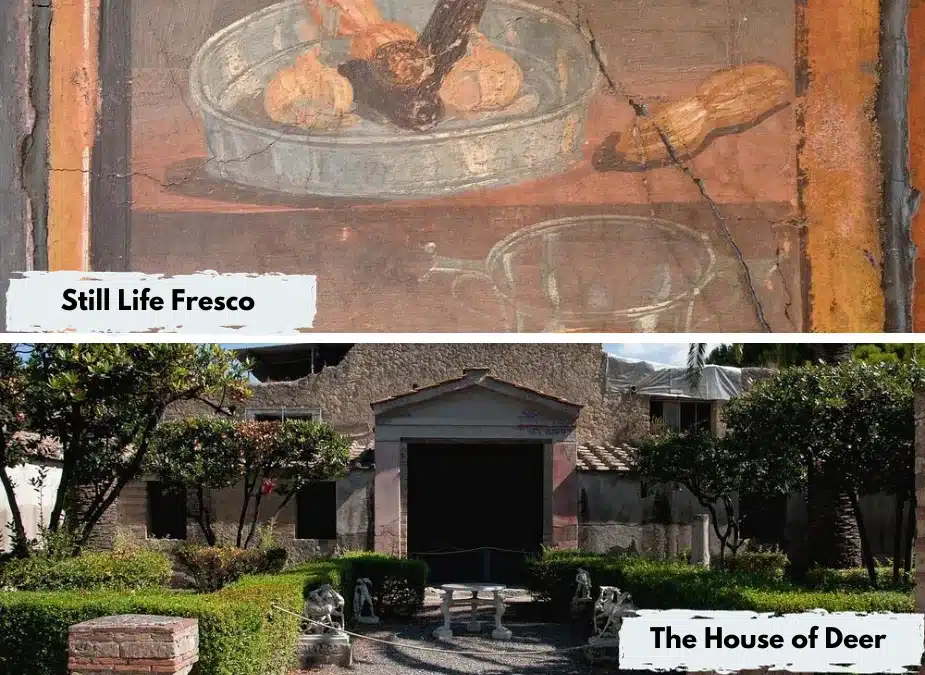
The House of Deer, Still Life Fresco
Further down, close to the seafront, stands an impressive noble residence, also known as the House Deer.
This two-story structure, organized around a central courtyard, features stunning ‘fourth style’ paintings displaying still-life and architectural scenes.
Its terrace garden, offering breathtaking views of the Bay of Naples, holds replicas of two marble sculptures depicting deer under attack by dogs—the original versions were discovered within the garden.
Archaeologists suggest that the affluent merchant Q. Granius Verus owned the house; evidence includes his stamp on a preserved loaf of bread uncovered amidst the volcanic ash.

The House of Relief in Herculaneum
The House of Relief in Herculaneum
Look to the other side of the same street; there’s a House of the Relief of Telephus, one of the largest houses in Herculaneum, covering around 1800 sq. m (20,000 sq. feet).
The atrium, decorated in the ‘third style,’ showcases yellow panels and features marble discs known as oscilla, replicated and suspended between the columns.
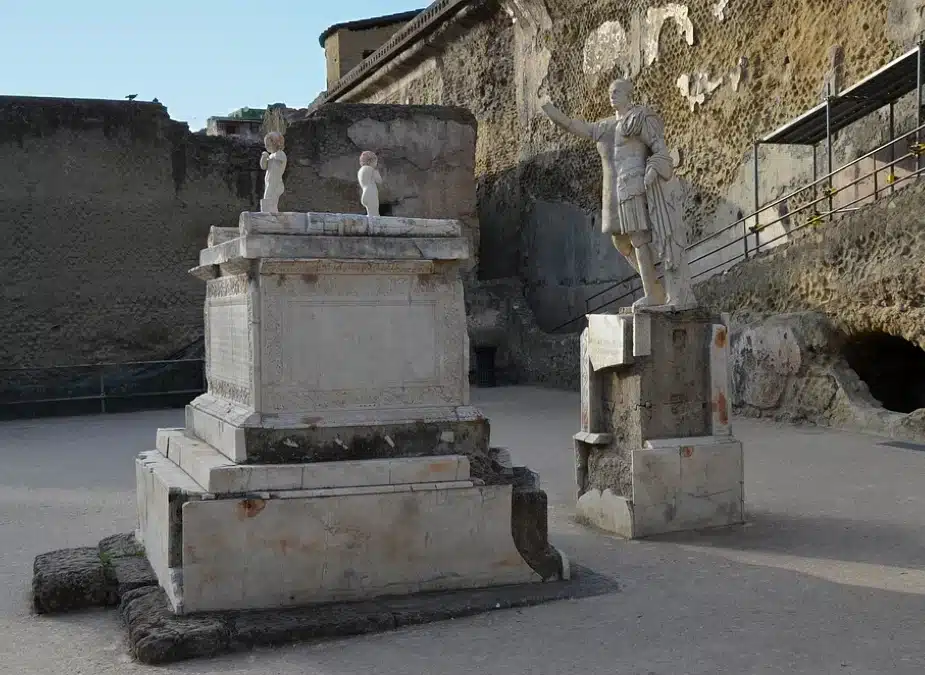
Funerary Altar and Statue of Marcus Nonius Balbus in Herculaneum
South of the House of the Relief of Telephus lies the Suburban District, an ancient waterfront area accessible through the Marina Gate.
The district features the prominent Terrace of Marcus Nonius Balbus, honoring his contributions as a key figure in Herculaneum during the Augustan period.
Balbus, a significant benefactor to the town, was honored with statues and inscriptions for his civic endeavors and governance.
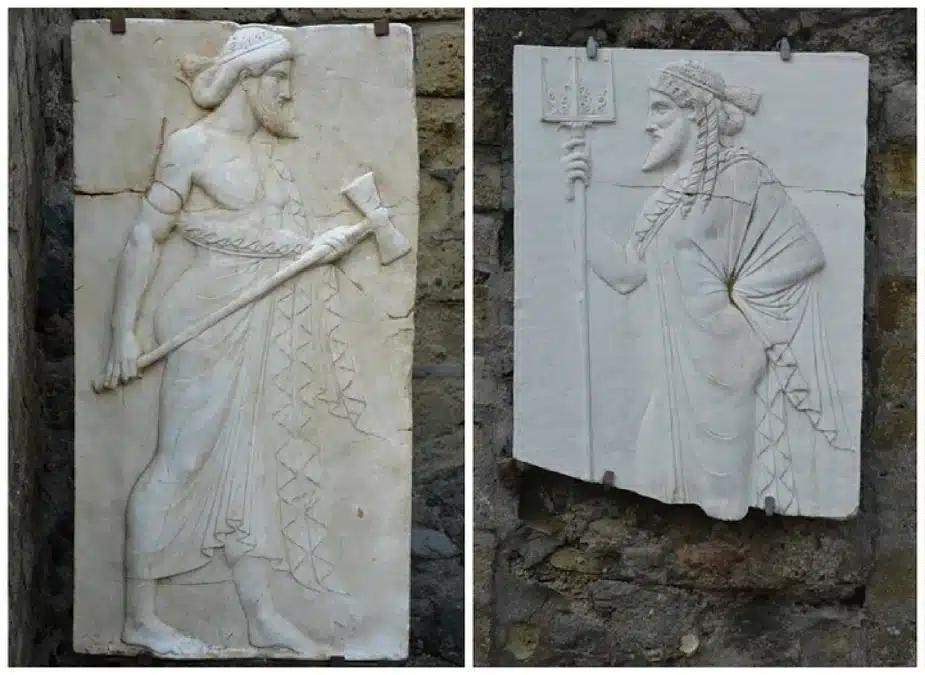
Vulcan, Neptune, Mercury and Minerva in Herculaneum
Vulcan, Neptune, Mercury and Minerva in Herculaneum
To the east of the terrace, you’ll find the well-preserved Roman Bath complexes known for their marble floors and mosaic, stuccoed walls, statues and ceiling decoration.
And to its west is a sacred area housing two shrines, the first dedicated to Venus and the second dedicated to three Gods, Neptune, Vulcan, Mercury and Goddess Minerva, evident from the relief present.

Theatre of Herculaneum
Theatre of Herculaneum
Explore Herculaneum’s ancient theater beyond the archaeological park along Corso Resina.
Accessible through Bourbon-era tunnels, it descends 20 meters underground.
The theater held 2,500 spectators in the Augustan period, adorned with marble and statues, now at the Naples Archaeological Museum.
Featured Image: Image: (Google.com/maps)|Image: Nytimes.com|Image: Worldhistory.org



